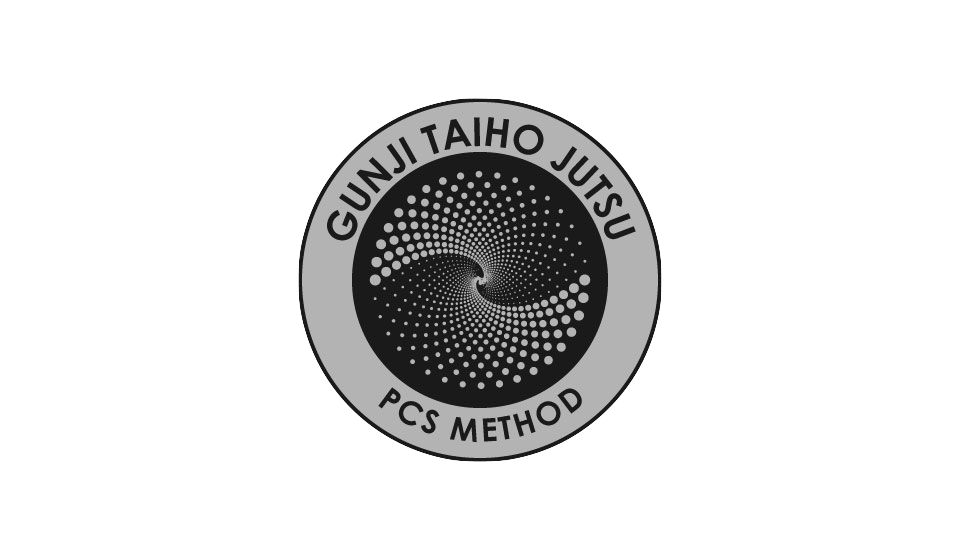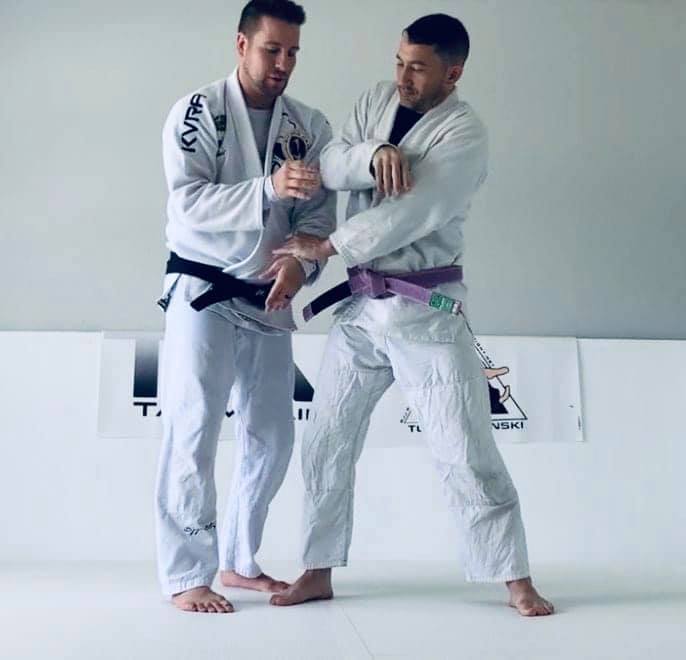Concepts of PCS and Straight Punches
This video explores concepts from PCS 2 and countering straight punches. Week 11. To give this instructional the right context after 10 weeks of instruction, you as a Gunji Taiho Jutsu practitioner will be able to have a great understanding of specific objectives for arresting technique. There is much to cover, study, and train in Gunji Taiho Jutsu.
To The Reader
The author will be most happy to receive your comments, including criticisms and suggestions. Noteworthy comments may be included in future editions or books on this series.
– Prof. “little” Tony Pacenski
Yokota Air Base – Tokyo Japan
Gunji Taiho Jutsu (GTJ) | Military Arresting Technique is a system of taiho jutsu that is a progressive way to teach Military or Law Enforcement personnel many of the traditional and contemporary jujutsu techniques of control and arrest while at the same time keeping mindful of secondary weapon systems during training and complementing all of the current and evolving Military Com...
Gunji Taiho Jutsu Develops 1st Form for Arresting Technique
Gunji Taiho Jutsu and the Roots of Creating the Little Circle Pin called Little Maru
Gunji Taiho Jutsu is a type system of Taiho Jutsu (Arresting Technique) that has roots in different cultures and Martial Arts styles. One goal of Gunji (Military) Taiho Jutsu was to act as a reformer to arresting technique. The facts are many Taiho Jutsu systems, if you even know what the word means, do not work under stress. Gunji Taiho Jutsu (GTJ) saw this issue as an opportunity to make changes. The first thing that we did was develop the governing strategy of PCS 1, PCS 2, and PCS 3. Having PCS as an operating system is an effective way to understand, see and apply arresting techniques. It gives that Military Personnel or Officer stages and objectives for reaching goals.
PCS 3 essentially means Pin, Safety, and Communication. With an effective pin, an Officer can apply cuffing techniques. In GTJ, we have handcuffing methodologies that we called GTJ Direct Handcuffing Method. This is a topic for a different day; however, GTJ Direct Handcuffing Methods will never be applied if...
Military Arresting Technique (Gunji Taiho Jutsu) Universal Arm Control

Gunji Taiho Jutsu (GTJ) | Military Arresting Technique is a system of taiho jutsu that is a progressive way to teach Military or Law Enforcement personnel many of the traditional and contemporary jujutsu techniques of control and arrest while at the same time keeping mindful of secondary weapon systems during training and complementing all of the current and evolving Military Combatives programs in place for the different branches of the Military. One aspect of GTJ that is complementary to many Combatives systems is the concept of finding central common themes. The GTJ system will take this strategy or technique and expand on it. In other words, challenge and test the technique under pressure. A universal technique found in reality-based training, combatives, and arresting technique circles is the two on one arm-control position. In Gunji University, this type of position is governed by the PCS 2 principles that are unique to GTJ. PCS 2 stands for Position, Control and System of ...
Gunji Taiho Jutsu Weaponry Core - 4
Training in a weapon-based environment requires new skillsets and mindsets. What can be applied in Martial Arts and Combatives without having a weapon in the struggle gives much more freedom although still presents many challenges. A great drill to practice in Combatives training is to begin sparring with one person having a hidden weapon. When the instructor gives the cue, one of the training partners will pull the weapon out. This will quickly change the dynamic of the drill. The weapon is an equalizer for the person that does not have the skills in hand-to-hand Combatives.
When it came time to develop the Gunji Taiho Jutsu's (GTJ) weaponry curriculum, we went for the structure of building off the foundations of Military Combatives and what is explore in Military Basic Training. This includes self-defense movements against weapons, offensive attacks with the long gun, and how to survive. With this in mind, GTJ's weaponry core needed to follow principles and go further than Mili...
Gunji Taiho Jutsu - 3 Grappling Survival Core
It is easy to make the statement that Military and Law Enforcement communities need to train in Martial Arts and Combatives. More specifically many will say that they need training in Grappling and Jiu-Jitsu. Everything here is not wrong. By practicing Martial Arts and grappling-based Combatives, Military personnel will gain many more benefits other than learning defensive and offensive moves. There are lists of benefits that can be written on the value of training and receiving better confidence in yourself and the confidence to do your job.
When it came time to develop the Gunji Taiho Jutsu's (GTJ) grappling curriculum, we went for the context of Grappling Survival and the core positions in arresting arts. This includes grappling-base self-defense movements, stand up grappling, and ground survival. With this in mind, GTJ's grappling survival core needed to follow principles and try not to be so "Brazilian Jiu-Jitsu-centric." I will expand.
Sometimes finding yourself on the gro...
GTJ Military Combatives Core - Striking

To practice Military Combatives is a broad stroke understanding Martial Arts tactics. In Gunji Taiho Jutsu (GTJ), the second curriculum for students is the GTJ Military Combatives Core. We get very specific in our practice and training to focus on how to use stances, movement, offensive, and defensive techniques and strategies. The objectives are to teach as close as possible to Military Combatives programs in place; however, to build off this core to incorporate additional concepts and techniques that are useful for arresting technique. The results have been amazing in finding what we call bridging techniques that link Combatives systems and different Martial Arts.

One of the most important elements of the GTJ Military Striking Core curriculum is the stance work and using movement effectively. We have made progress in our system of taiho jutsu build off of and link the footwork strategy called the V-Step or the X-Step. This technique comes from Filipino Martial Arts (FMA). You will...
Curriculums of Gunji Taiho Jutsu
Gunji Taiho Jutsu (GTJ) is years ahead of any taiho jutsu system in the World. You can read that topic sentence again and some may think that is a bold statement. Well, we started this journey of arresting techniques to be different. To take the classical arts that makeup taiho jutsu from Japan and supercharge it with new approaches that are modern and under the lens of Military Combatives. GTJ is just that Military Arrest Technique that values pressure testing, resistance and is taught with excellence through our teaching pedagogies and presentations strategies. The results have been amazing. It has come at this time to take a look at the GTJ system of Taiho Jutsu. The purpose of this writing is to introduce you to the 7 plus curriculums that make up GTJ and are taught at Gunji University. These curriculums are: The foundational blocks of GTJ are the GTJ Pinning Core, GTJ Military Combatives Core, and GTJ Grappling Survival Core. Becoming proficient in one of these curriculums ...
The foundational blocks of GTJ are the GTJ Pinning Core, GTJ Military Combatives Core, and GTJ Grappling Survival Core. Becoming proficient in one of these curriculums ...
Please Just Stop Teaching This To Law Enforcement

The Dinosaur Gooseneck Wristlock
You will be surprised how many instructors that teach "Defensive Tactics", "Law Enforcement Tactics" or "Taiho Jutsu" show the front gooseneck wristlock. This type of compression lock is often taught in the context of what is called a come-along strategy. "Use this come-along to move the suspect where you want," is what the instructor will show the group. I am here to let you know that in Gunji Taiho Jutsu (GTJ) and in Gunji University's curriculums we do not teach the front gooseneck come-along compression wristlock.



No students never ask the question to the "Defensive Tactics" instructor, what if the suspect uses his free hand to punch or to control his wrist? The answer is the suspect will in real life punch your face or break up the position with his free hand. This type of goose-neck hand positioning is very old, continues to be taught, and is not effective one-on-one when tested. The front gooseneck is effective, however, when there is ...
What You NEED TO KNOW RIGHT NOW - Arresting Pin with Communication and Safety = PCS 3.
(Video from Week 11 Gunji University Online Curriculum-originally recorded Sept 2018)


